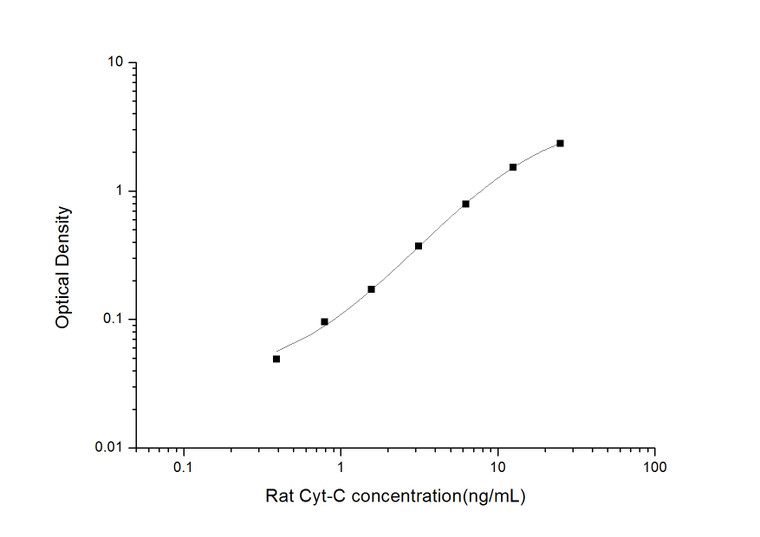| Applications: |
ELISA |
| Reactivity: |
Rat |
| Note: |
FOR SCIENTIFIC EDUCATIONAL RESEARCH USE ONLY (RUO). MUST NOT BE USED IN DIAGNOSTIC OR OTHER MEDICAL APPLICATIONS. |
| Sensitivity: |
0.23ng/mL |
| Detection Limit: |
0.39~25ng/mL |
| Short Description: |
This Cycs Sandwich ELISA is an in-vitro enzyme-linked immunosorbent assay for the measurement of samples in rat cell culture supernatant, serum and plasma (EDTA, citrate, heparin). |
| Storage Instruction: |
If unopened the kit may be stored at 2-8°C for up to 1 month. If the kit will not be used within 1 month, store the components separately, according to the component table in the manual. |
| Assay Time: |
3.5h |
| Detection: |
Colormetric |
| Gene Symbol: |
Cycs |
| Gene ID: |
25309 |
| Uniprot ID: |
CYC_RAT |
| Specificity: |
This kit recognizes Rat Cyt-C in samples. No significant cross-reactivity or interference between Rat Cyt-C and analogues was observed. |
| Sample Type: |
Serum, plasma and other biological fluids |
| Post Translational Modifications | Binds 1 heme c group covalently per subunit. Phosphorylation at Tyr-49 and Tyr-98 both reduce by half the turnover in the reaction with cytochrome c oxidase, down-regulating mitochondrial respiration. |
| Function | Electron carrier protein. The oxidized form of the cytochrome c heme group can accept an electron from the heme group of the cytochrome c1 subunit of cytochrome reductase. Cytochrome c then transfers this electron to the cytochrome oxidase complex, the final protein carrier in the mitochondrial electron-transport chain. Plays a role in apoptosis. Suppression of the anti-apoptotic members or activation of the pro-apoptotic members of the Bcl-2 family leads to altered mitochondrial membrane permeability resulting in release of cytochrome c into the cytosol. Binding of cytochrome c to Apaf-1 triggers the activation of caspase-9, which then accelerates apoptosis by activating other caspases. |
| Protein Name | Cytochrome C - Somatic |
| Database Links | Reactome: R-RNO-111457Reactome: -RNO-111458Reactome: -RNO-111459Reactome: -RNO-2151201Reactome: -RNO-3299685Reactome: -RNO-5620971Reactome: -RNO-5628897Reactome: -RNO-611105Reactome: -RNO-9627069Reactome: -RNO-9707564 |
| Cellular Localisation | Mitochondrion Intermembrane SpaceLoosely Associated With The Inner Membrane |
| Alternative ELISA Names | Cytochrome C - Somatic ELISA kitCycs ELISA kit |
| Specificity | This kit recognizes Rat Cyt-C in samples. No significant cross-reactivity or interference between Rat Cyt-C and analogues was observed. |
| Reproducibility | Both intra-CV and inter-CV are |
Information sourced from Uniprot.org
| Item | Specifications | Storage |
| Micro ELISA Plate (Dismountable) | 96T: 8 wells ×12 strips strips | -20℃, 6 months |
| Reference Standard | 96T: 2 vials 48T: 1 vial | -20℃, 6 months |
| Concentrated Biotinylated Detection Ab (100×) | 96T: 1 vial, 120 μL 60 μL | -20℃, 6 months |
| Concentrated HRP Conjugate (100×) | 96T: 1 vial, 120 μL 60 μL | -20℃ (Protect from light), 6 months |
| Reference Standard & Sample Diluent | 1 vial, 20 mL | 2-8°C, 6 months |
| Biotinylated Detection Ab Diluent | 1 vial, 14 mL | 2-8°C, 6 months |
| HRP Conjugate Diluent | 1 vial, 14 mL | 2-8°C, 6 months |
| Concentrated Wash Buffer (25×) | 1 vial, 30 mL | 2-8°C, 6 months |
| Substrate Reagent | 1 vial, 10 mL | 2-8℃ (Protect from light) |
| Stop Solution | 1 vial, 10 mL | 2-8°C |
| Plate Sealer | 5 pieces | |
| Manual | 1 copy | |
| Certificate of Analysis | 1 copy | |
| Sample Type | Range (%) | Average Recovery (%) |
| Serum(n=8) | 90-105 | 97 |
| EDTA plasma (n=8) | 86-97 | 91 |
| Cell culture media (n=8) | 96-107 | 102 |
| | Intra-assay Precision | Intra-assay Precision | Intra-assay Precision | Inter-assay Precision | Inter-assay Precision | Inter-assay Precision |
| Sample | 1.00 | 2.00 | 3.00 | 1.00 | 2.00 | 3.00 |
| n | 20.00 | 20.00 | 20.00 | 20.00 | 20.00 | 20.00 |
| Mean (ng/mL) | 1.33 | 4.00 | 8.84 | 1.36 | 3.69 | 8.71 |
| Standard deviation | 0.08 | 0.16 | 0.28 | 0.09 | 0.17 | 0.29 |
| CV (%) | 6.02 | 4.00 | 3.17 | 6.62 | 4.61 | 3.33 |
12 months for antibodies. 6 months for ELISA Kits. Please see website T&Cs for further guidance







